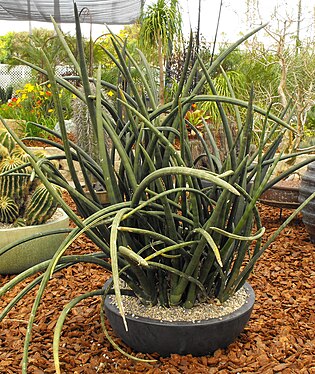Difference between revisions of "Sansevieria cylindrica"
| Line 58: | Line 58: | ||
==References== | ==References== | ||
| − | + | {{reflist}} | |
*[[Standard Cyclopedia of Horticulture]], by L. H. Bailey, MacMillan Co., 1963 | *[[Standard Cyclopedia of Horticulture]], by L. H. Bailey, MacMillan Co., 1963 | ||
<!--- xxxxx *Flora: The Gardener's Bible, by Sean Hogan. Global Book Publishing, 2003. ISBN 0881925381 --> | <!--- xxxxx *Flora: The Gardener's Bible, by Sean Hogan. Global Book Publishing, 2003. ISBN 0881925381 --> | ||
Latest revision as of 20:09, 11 May 2010
| Habit | cacti-succulent
| |
|---|---|---|
| Height: | ⇕ | 16 in"in" can not be assigned to a declared number type with value 16. |
| Width: | ⇔ | 5 ft"ft" can not be assigned to a declared number type with value 5. |
| Lifespan: | ⌛ | perennial |
| Bloom: | ❀ | early summer, mid summer, late summer |
| Exposure: | ☼ | part-sun |
|---|---|---|
| Water: | ◍ | moderate, dry |
| Features: | ✓ | flowers, foliage, houseplant |
| USDA Zones: | 10 to 11 | |
| Flower features: | ❀ | white |
|
Bojer > |
Sansevieria cylindrica, also known as the Cylindrical Snake Plant, African Spear or Spear Sansevieria,[1] is a succulent plant native to Angola.
S. cylindrica has striped, round leaves that are smooth and a green-gray color. A single leaf is about 3 cm in 0 thick and grows to a height between 1 m ft 0 and 2 m ft 0.[1] The Spear Sansevieria grows fan-shaped, with its stiff leaves growing from a basal rosette. The species is interesting in having rounded instead of strap-shaped leaves caused by a failure to express genes which would cause the cylindrical bud to differentiate dorsoventrally or produce a distinctive and familiar top and bottom surface to the leaf blade.[1][2] The plant blooms once a year in the spring or mid-summer,[3] producing 3 cm in 0 greenish-white tubular flowers tinged with pink.[2] The species is drought-tolerant and in captivity needs water only about once every other week during the breeding season.[2] The species was described by Wenceslas Bojer in 1837. Sansevieria cylindrica received its name from a competition in a Dutch national newspaper.[1] It is popular as an ornamental plant[1] as it is easy to culture and take care of in a home.[2]
Read about Sansevieria cylindrica in the Standard Cyclopedia of Horticulture
|
|---|
|
Sansevieria cylindrica, Bojer. Lvs. often 3-4 ft. long, 8-10 in a tuft, terete, solid within, dark green, often banded with paler lines, acuminate, occasionally furrowed: scape with infl. shorter than the lvs.: raceme about 1 ft. long; fls. creamy white, tinged with pink. Trop. Afr.
|
Cultivation
Propagation
Pests and diseases
Varieties
Gallery
References
- ↑ 1.0 1.1 1.2 1.3 1.4 Thongthiraj, Rahpee. "Get Inspired with Sansevierias: The Perfect Solution for Your Home Garden". California Cactus Center. Retrieved on 2008-04-02.
- ↑ 2.0 2.1 2.2 2.3 Lemke, Cal (2002-01-25). "Sanseviera cylindrica". Plant of the Week. University of Oklahoma Department of Biology and Microbiology. Retrieved on 2008-04-02.
- ↑ "PlantFiles: Spear Sansevieria". PlantFiles. Dave’s Garden. Retrieved on 2008-04-02.
- Standard Cyclopedia of Horticulture, by L. H. Bailey, MacMillan Co., 1963
External links
- w:Sansevieria cylindrica. Some of the material on this page may be from Wikipedia, under the Creative Commons license.
- Sansevieria cylindrica QR Code (Size 50, 100, 200, 500)



